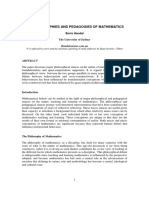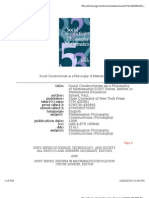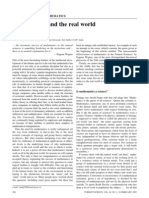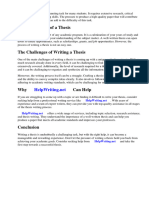Perspectives On Mathematics: Undar Arukkai
Perspectives On Mathematics: Undar Arukkai
Uploaded by
jayasankar82Copyright:
Available Formats
Perspectives On Mathematics: Undar Arukkai
Perspectives On Mathematics: Undar Arukkai
Uploaded by
jayasankar82Original Title
Copyright
Available Formats
Share this document
Did you find this document useful?
Is this content inappropriate?
Copyright:
Available Formats
Perspectives On Mathematics: Undar Arukkai
Perspectives On Mathematics: Undar Arukkai
Uploaded by
jayasankar82Copyright:
Available Formats
Perspectives on Mathematics
This collection of seven papers is an indication of the kinds of issues involved in understanding mathematics in a broader perspective. What we hope to achieve is to generate insights into understanding one of the most creative languages humans have created and instil a more balanced response to mathematics as a language, culture and a living presence amidst all of us.
SUNDAR SARUKKAI
he development of the disciplines of history, philosophy and sociology of science has given us a deeper and nuanced understanding of the practice and implications of modern science. As a consequence, the epistemological primacy of science has been challenged in various ways. Over the last two decades, postmodernism has contributed to this debate by bringing in fresh and radical perspectives on science. In the ruins of this fight stands mathematics strong and unsullied. While charges of violence, aggression and hegemony have been piled on the method and practice of science, mathematics in large part has managed to escape such attacks and continues to present a cool, detached and logical face. This is surprising because it has long been held that without mathematics there is no modern science and moreover the unique character of scientific knowledge depends on the use of mathematics. I believe that the difficulty and inaccessibility in learning and knowing mathematics have been important factors in isolating mathematics from even bitter critics of science. In creating its image, mathematics has turned out to be very successful. By projecting itself as an extremely hard discipline, mathematics has built a fortress around it, inaccessible to intrusions from unfriendly people and disciplines. The process of seclusion is strengthened by the contention that mathematics is a formal, axiomatic, deductive and logical system, which is concerned only with a platonic world and whose connection with our real world is only incidental and perhaps even mysterious. It has also been consistently claimed that mathematics is universal, acultural and ahistorical. Further, this image serves to guard mathematics against the perceived vagaries of verbal languages. This image is definitely a conscious and cultivated one meant for those outside mathematics. Outsiders include scientists who have actually served to legitimise mathematics by successfully applying it. However, we can effectively challenge this image of mathematics. It has been done before, although sporadically, and ironically, by a few mathematicians who have pointed out to some essential human and cultural aspects in mathematics such as aesthetics, convenience, subjectivity and so on. These observations have not only been sporadic but also the outsiders have not been in sufficient strength to understand and build on these observations. In recent years, though, this trend is changing. The collection of seven papers that follows is an indication of the kinds of issues involved in understanding mathematics in a broader perspective. One of the most enduring images of mathematics is its universality, meaning that mathematical truths and propositions are the same for every person not only in this world but even the conceivable universe. Different cultures may have different languages and different habits but not different mathematics. The
first paper by Narasimha gives an example of how there are actually two cultures of mathematics. From a historical perspective, he argues that mathematics can be done in two different ways, axiomatic and algorithmic, which constitute the two cultures of mathematics. The axiomatic way of doing mathematics is to build this subject from axioms, theorems and models. This was a path pioneered by the Greeks and one which has informed the growth of almost all of modern mathematics. In contrast, the computational, algorithmic method was favoured by ancient Indian mathematicians and astronomers. There is an essential difference in the way the Indians and Greeks approached the study and development of mathematics, thereby suggesting that there are indeed two ways of doing mathematics. Is it by accident that two different cultures adopted two different, yet valid, ways of doing mathematics? Interestingly, after the advent of computers, there has been a paradigm shift, both in mathematics and sciences, which privileges the computational method. Narasimha concludes by noting that the presence of two cultures in mathematics might suggest how there might be multiple routes to what may be seen as scientific knowledge . Philosophy has attempted to address the issue of mathematics in different ways. Although philosophy of mathematics has dominantly been influenced by the logical and analytical tradition, other traditions such as phenomenology offer us different perspectives on the philosophical foundations of mathematics. The next paper by Sanil describes an interesting phenomenological analysis of mathematics by trying to find a meeting ground between art and mathematics. One such ground is through aesthetics, which is common to both mathematics and art. Phenomenology, as Sanil notes, offers another ground. By introducing Husserls influential views on mathematics, and in particular his conceptualisation of geometry, he shows how a phenomenological approach to mathematics illustrates various other ways of understanding mathematics. For example, Husserls search for the origin of geometry leads him to thematise geometry in terms of history. As Sanil notes, to acquire the sense of geometry [is] to acquire a sense of history or sense as history. Gadamers account of the meaning of the art object as the sense accrued in history means that phenomenology brings together art and mathematics in a shared sense of history. Moreover, in the phenomenological tradition of Husserl and Heidegger, technology has been seen as adversarial to mathematics. By making an interesting connection between the ontology of mathematics and that of the cinematic image, Sanil goes on to consider the relation between mathematics, cinema and technology, in particular digital technology, thus finding a foundational ground common to both mathematics and art. Arguably, the most important reason for the high status of mathematics is its applicability in the sciences, including social
3648
Economic and Political Weekly
August 30, 2003
sciences. This applicability has been termed as being unreasonably effective and as something mysterious. In the third paper, Sarukkai considers this issue of applicability through the rubric of language and the relationship between language and reality. He argues that mathematics has to be seen as a language in that it shares many important characteristics with verbal languages even as there are important differences between them. When a language is used to describe a world, in a sense it is being applied. Then, what is the difference between applying mathematics and applying a language like English? He notes that the relation between mathematics and science is itself quite complex, especially since the domain of mathematics is much vaster than that used in science. Moreover, the development of mathematics is in general quite indifferent to science. Thus, to understand the notion of applicability as well as its success, it is important to look at mathematics as language and discourse. Once we attempt to understand the notion of applicability in terms of language, we discover some commonalities and differences in applying mathematics and English. One of the conclusions he draws from this analysis is that mathematics is actually a family of languages. Finally, he offers one explanation for the success of applying mathematics. This is based on the use of multisemiotic systems in applied mathematics, which becomes a discursive strategy to create multiple narratives about a phenomenon. The applicability of mathematics in physics has led to similar attempts in almost all fields. The use of mathematics in biology is an interesting case study of the limitations of the use of mathematics in a science like biology, which is seen to be closer to the physical sciences than the social sciences. The next paper by Nanjundiah considers the role of mathematics in biology. He notes that biology is mid-way between the physical and social sciences. Thus, its experiences with mathematics should be of interest to social sciences. Nanjundiah argues that the evolutionary aspect of life and living beings makes it very difficult to reduce biology to physics and chemistry. Moreover, the notions of change and chance are central to evolution, thereby making evolution unpredictable. To add to this, there are serious discontinuities in evolution which makes it impossible to account for what happened after it in terms of what was happening before. Because of evolution, the notion of history becomes central to biology. Given this complexity, a complexity that is symptomatic of the kind of complexities social sciences face, how does mathematics respond to it? Not very well, according to Nanjundiah. Mathematics becomes useful in biology only if we look at biological systems narrowly, which includes ignoring evolutionary historicity. However, if we incorporate anything more complex, especially the ad hoc nature of evolution, then mathematisation runs into serious problems. Interestingly, just as in Sanils paper, the issue of history seems to be somehow closely linked with the project of mathematics! The fifth and sixth papers deal explicitly with the use of mathematics in social sciences. First, Karmeshu and Jains paper illustrates how one can use mathematics to model social systems. An early critique of mathematisation in social sciences was that mathematics could describe physical systems only through ideal models, which were simple in comparison to real phenomena. Therefore, the use of mathematics is inherently unsuitable for modelling complex social phenomena. But the development of new ideas in physics, particularly the analysis of nonlinear systems and complex behaviour, opened up new vistas to model complex phenomena including those in the study of social systems. This paper uses the fertile idea of nonlinearity to model a range of social phenomena including diffusion of innovation, positive feedback in economics, technology substitution, urbanisation
patterns, arms race model between two nations and dynamics of domestic political conflict. These models capture some idea of the complexity in social systems and processes. While they may be limited in some sense, like all mathematical models are, they are also instrumental in opening up new ways of understanding such complex processes and seeing patterns that may not be visible otherwise. The next paper by Pani, while not a response to the previous one, addresses issues that directly arise from attempts to mathematise social phenomena. Panis focus is economics and he first begins with a careful study of how mathematisation has been understood by economists. He then offers a summary of the criticism against mathematisation. Of particular interest is the observation made by many that mathematical economists are more like mathematicians than physicists, in effect, critiquing the way in which mathematics is being used in economics. One of the most important reasons offered for mathematisation is the possibility of having objectivity in the description and explanation of economic processes. Pani argues that mathematical models in economics are narrowly focused because they have not been able to incorporate the notion of subjective judgment in their formulations. This leads him to consider how one could formulate subjectivity in economic theories and the problems that could arise in an economist making non-objective judgments. One way in which subjective judgments can be used is to reduce them to a set of objective statements but Pani finds this problematic. This emphasis on subjectivity by Pani does not subscribe to the slogan of anything goes. Instead, he looks at how one can improve the quality of subjective judgments in mathematical economics. He argues that there are two examples already available to improve the quality of such judgments, namely, the idea of expediency as used by Gandhi and Keynes attempts to develop objective tests based on ideas of probability and partial belief. Finally, we come back to an important concern about mathematics. One of the reasons why the traditional image of mathematics, discussed in the beginning of this introduction, continues to be reinforced has to do with learning and teaching mathematics. Much work has been done in the field of education in trying to find new methods to teach mathematics. In the last paper, Subramaniam discusses the problems in teaching and learning elementary mathematics. What is of interest in this process is to discover how children learn, especially the learning of abstract mathematical objects like numbers as well as abstract operations both in arithmetic and algebra. This paper discusses interesting examples of how students learn the idea of numbers, arithmetical operations, the = sign and symbolic terms as they occur in algebra. Subramaniam concludes by noting that there are no special cognitive abilities required to learn school mathematics. The difficulty associated with mathematics may be reflective of nothing more than bad teachers or bad teaching methods. These perspectives do not obviously cover the full story. The association of logic with mathematics has not been discussed here, not only because it has been a part of standard literature but also because for social scientists it is important to look at mathematics beyond the limitations of logic. Other omissions include discussion of standard issues in philosophy of mathematics ranging from formalism, intuitionalism and constructivism. What we hope to achieve in this set of papers is to generate new insights into understanding one of the most creative languages humans have created. By bringing it into our imagination, not with distrust but with sufficient awareness, we hope to instil a more balanced response to mathematics as a language, culture and a living presence amidst all of us. -29
Economic and Political Weekly
August 30, 2003
3649
You might also like
- D'Ambrosio, U. (1985) - Ethnomathematics and Its Place in The History and Pedagogy of Mathematics. For The Learning of Mathematics, 5 (1), 44-48Document5 pagesD'Ambrosio, U. (1985) - Ethnomathematics and Its Place in The History and Pedagogy of Mathematics. For The Learning of Mathematics, 5 (1), 44-48MUHAMMAD AMIRUL SYAZWAN ISMAIL100% (1)
- Xin Wei Sha Poiesis and Enchantment in Topological Matter PDFDocument382 pagesXin Wei Sha Poiesis and Enchantment in Topological Matter PDFMaurizioLeonardi100% (1)
- Mathematics Education and Culture Interaction PDFDocument14 pagesMathematics Education and Culture Interaction PDFbengersonNo ratings yet
- 777 Philosophies and Pedagogies of MathematicsDocument12 pages777 Philosophies and Pedagogies of MathematicsDane SinclairNo ratings yet
- Mark Robert DDocument2 pagesMark Robert DEmman BasayaNo ratings yet
- Modern MathDocument51 pagesModern MathLurenne De CastroNo ratings yet
- HandalDocument9 pagesHandalsagheer ahmadNo ratings yet
- Tok Devlin What Is MathematicsDocument4 pagesTok Devlin What Is MathematicsJessyHooNo ratings yet
- History Deg.Document33 pagesHistory Deg.Hamisu TafashiyaNo ratings yet
- mth112 NotesDocument84 pagesmth112 NotesSamson RamusNo ratings yet
- The Scientific Legacy of Oriental Scholars in The Development of Mathematical ScienceDocument3 pagesThe Scientific Legacy of Oriental Scholars in The Development of Mathematical ScienceresearchparksNo ratings yet
- Maths and PhilosophyDocument9 pagesMaths and PhilosophyLaiaNo ratings yet
- Math and The Language of NatureDocument13 pagesMath and The Language of NatureFlor Constanza100% (1)
- Math EdDocument7 pagesMath EdAmber HabibNo ratings yet
- Maths PPT PrepDocument5 pagesMaths PPT Prepanumulasuchitra123No ratings yet
- Mth112 Notes 2Document78 pagesMth112 Notes 2kingsleyNo ratings yet
- Set Theory and Logic: University of ZimbabweDocument78 pagesSet Theory and Logic: University of ZimbabwekingsleyNo ratings yet
- Mth112 NotesDocument80 pagesMth112 NotesmadzkelvinNo ratings yet
- Background ReadingDocument7 pagesBackground ReadingHoussem NasriNo ratings yet
- Cultures of Mathematics and Logic: Shier Ju Benedikt Löwe Thomas Müller Yun Xie EditorsDocument130 pagesCultures of Mathematics and Logic: Shier Ju Benedikt Löwe Thomas Müller Yun Xie EditorsNatia LombardoNo ratings yet
- AcknowledgmebntDocument266 pagesAcknowledgmebntHrituparna RoyNo ratings yet
- Philosophies 05 00002 v2 PDFDocument12 pagesPhilosophies 05 00002 v2 PDFJuan RamirezNo ratings yet
- JunaDocument8 pagesJunaLionel Andreas BramaNo ratings yet
- What Is Mathematics?: 1 More Than ArithmeticDocument7 pagesWhat Is Mathematics?: 1 More Than ArithmeticNathaniel LewisNo ratings yet
- Title: Author: Publisher: Isbn10 - Asin: Print Isbn13: Ebook Isbn13: Language: Subject Publication Date: LCC: DDC: SubjectDocument305 pagesTitle: Author: Publisher: Isbn10 - Asin: Print Isbn13: Ebook Isbn13: Language: Subject Publication Date: LCC: DDC: SubjectrosnetNo ratings yet
- Mathematics As ScienceDocument2 pagesMathematics As ScienceLester GibbsNo ratings yet
- On The Dual Nature of Mathematical ConceDocument37 pagesOn The Dual Nature of Mathematical ConceSinai SantosNo ratings yet
- Almeida - Is There Mathematics in The ForestDocument13 pagesAlmeida - Is There Mathematics in The ForestJennifer PadillaNo ratings yet
- ChapterDocument7 pagesChapterAgata Cristine CabreraNo ratings yet
- Mathematics A Human EndeavourDocument10 pagesMathematics A Human EndeavournavincoolguyNo ratings yet
- Mathematics From Servant To Partner 1993Document25 pagesMathematics From Servant To Partner 1993Unlock GamingNo ratings yet
- EldlingDocument23 pagesEldlingClaudio Daniel PerezNo ratings yet
- Is Math A ScienceDocument4 pagesIs Math A ScienceVishal GaubaNo ratings yet
- Diving Into Complexity: Developing Probabilistic Decentralized Thinking Through Role-Playing ActivitiesDocument18 pagesDiving Into Complexity: Developing Probabilistic Decentralized Thinking Through Role-Playing ActivitiesBruno SperbNo ratings yet
- Sanet - ST 085729699XDocument904 pagesSanet - ST 085729699Xmanin1No ratings yet
- Towards A Diagrammatic Classification: Valeria GiardinoDocument13 pagesTowards A Diagrammatic Classification: Valeria Giardinoss5shaolinNo ratings yet
- Mathematics Is InventedDocument4 pagesMathematics Is InventedNorul-Izzah PaguitalNo ratings yet
- Word ProblemDocument14 pagesWord ProblemClara Patricia Rojas OrtizNo ratings yet
- Nkab 010Document35 pagesNkab 010AarishiNo ratings yet
- (Theory and History in the Human and Social Sciences) Amrei C. Joerchel, Gerhard Benetka - Memories of Gustav Ichheiser-Springer International Publishing (2018)Document252 pages(Theory and History in the Human and Social Sciences) Amrei C. Joerchel, Gerhard Benetka - Memories of Gustav Ichheiser-Springer International Publishing (2018)AngelicaNo ratings yet
- Mathematics Education and Its Cultural ContextDocument14 pagesMathematics Education and Its Cultural ContextSonia GalliNo ratings yet
- Association For Slavic, East European, and Eurasian Studies Is Collaborating With JSTOR To Digitize, Preserve and Extend Slavic ReviewDocument20 pagesAssociation For Slavic, East European, and Eurasian Studies Is Collaborating With JSTOR To Digitize, Preserve and Extend Slavic ReviewWendellNo ratings yet
- Mesquita and Restivo All Human Beings As Mathematical WorkersDocument14 pagesMesquita and Restivo All Human Beings As Mathematical WorkersBuddy OverthinkerNo ratings yet
- What Is MathematicsDocument2 pagesWhat Is MathematicsJaysonNo ratings yet
- Chapter 22: Epistemologies of Mathematics and of Mathematics EducationDocument50 pagesChapter 22: Epistemologies of Mathematics and of Mathematics Educationoa_matheusNo ratings yet
- Mathematics and RealityDocument27 pagesMathematics and RealityDavidNo ratings yet
- Pedagogy of Mathematics I 0Document48 pagesPedagogy of Mathematics I 0Amit YerpudeNo ratings yet
- Aishikin Final PaperDocument16 pagesAishikin Final Paperd-ichaNo ratings yet
- Philosophy of MathematicsDocument27 pagesPhilosophy of MathematicsBASHAR BINJINo ratings yet
- The Philosophy of MathematicsDocument22 pagesThe Philosophy of MathematicsAdmiralSTNo ratings yet
- Reaction PaperDocument4 pagesReaction Paperreyjanmaglinte20No ratings yet
- EnglishDocument1 pageEnglishLes SeñarNo ratings yet
- 2.1. Dossey, J. (1992)Document10 pages2.1. Dossey, J. (1992)Fransidha Sidhara HadiNo ratings yet
- Mathematical Analysis As A Source of Mainstream Economic Ideology - MissosDocument24 pagesMathematical Analysis As A Source of Mainstream Economic Ideology - MissosmakedonisNo ratings yet
- Mathematics and The Real World: R. RajaramanDocument6 pagesMathematics and The Real World: R. RajaramanChithira PaavaiNo ratings yet
- Beyond Geometry - A New Mathematics of Space and Form (The History of Mathematics)Document239 pagesBeyond Geometry - A New Mathematics of Space and Form (The History of Mathematics)ngp6311684100% (6)
- Prospectus: University of Bergen 2013/2014Document31 pagesProspectus: University of Bergen 2013/2014jayasankar82No ratings yet
- Instructions For Filling in The Application Form For Direct Admission To Ph.D. ProgrammeDocument6 pagesInstructions For Filling in The Application Form For Direct Admission To Ph.D. Programmejayasankar82No ratings yet
- Tokgjyky Usg: Fo'ofo - Ky : Jawaharlal Nehru UniversityDocument4 pagesTokgjyky Usg: Fo'ofo - Ky : Jawaharlal Nehru Universityjayasankar82No ratings yet
- NativeDocument83 pagesNativejayasankar82No ratings yet
- Textualizwg The History of Kerala: 1 - 1 Into TheoryDocument58 pagesTextualizwg The History of Kerala: 1 - 1 Into Theoryjayasankar82No ratings yet
- NativeDocument83 pagesNativejayasankar82No ratings yet
- Lexical Semantics Term Paper IdeasDocument6 pagesLexical Semantics Term Paper Ideasafdtunqho100% (1)
- Do It For SCJPDocument83 pagesDo It For SCJPhimanshu88kumarNo ratings yet
- 2024年版游戏生命周期白皮书-游戏趋势综览-Meta & PerforMadDocument27 pages2024年版游戏生命周期白皮书-游戏趋势综览-Meta & PerforMadSallow RingtineNo ratings yet
- Chapter 3, Review of Related LiteratureDocument32 pagesChapter 3, Review of Related LiteratureAlliah Thamara TendenillaNo ratings yet
- Apache VS16 Binaries and Modules DownloadDocument2 pagesApache VS16 Binaries and Modules DownloadjhademenosNo ratings yet
- SampleQnA StepPlusDocument21 pagesSampleQnA StepPlusPoobalan PadmanabanNo ratings yet
- 9 To 12 Syllabus CompleteDocument96 pages9 To 12 Syllabus CompleteSubhradeep GhoshalNo ratings yet
- LAB 04 - Gauss Jordan and Inverse of Matrices in MATLABDocument5 pagesLAB 04 - Gauss Jordan and Inverse of Matrices in MATLABCan Raps100% (1)
- PR Number: SIH Project: Alumni Tracking System Organization: DescriptionDocument2 pagesPR Number: SIH Project: Alumni Tracking System Organization: DescriptionNeerajNo ratings yet
- Casio Watch ManualDocument5 pagesCasio Watch ManualRay WongNo ratings yet
- Lesson 3 KENNDocument23 pagesLesson 3 KENNDiana Denise EbeteNo ratings yet
- ECCD ChecklistDocument2 pagesECCD ChecklistJonaphen C.GabalfinNo ratings yet
- Presentation of ArraysDocument9 pagesPresentation of ArraysShashank SatiNo ratings yet
- Voice ChangesDocument29 pagesVoice ChangesAl-Amin HossainNo ratings yet
- PRESTON 1989 Perceptual DialectologyDocument33 pagesPRESTON 1989 Perceptual DialectologyAmanda Timmen MelloNo ratings yet
- Phrasal Verbs GO!!Document1 pagePhrasal Verbs GO!!Andres Fabian CamargoNo ratings yet
- Holy Month of Shabaan PDFDocument10 pagesHoly Month of Shabaan PDFRoohiNo ratings yet
- BRAOU Eligibility Test Model Paper - Engligh Language, General Knowledge&Aptitude (Urdu)Document8 pagesBRAOU Eligibility Test Model Paper - Engligh Language, General Knowledge&Aptitude (Urdu)AnweshaBoseNo ratings yet
- HCI Unit2Document15 pagesHCI Unit2Danish Ahmad KhanNo ratings yet
- Unified Power FormatDocument3 pagesUnified Power FormatSameer NandagaveNo ratings yet
- ChangDocument1 pageChangTrung JuneNo ratings yet
- Template For Capstone ProposalDocument15 pagesTemplate For Capstone ProposalRomelia F. RelonNo ratings yet
- HEC-RAS Mapper Users Manual v6.5Document179 pagesHEC-RAS Mapper Users Manual v6.5Izzati Madihah100% (2)
- 12 Step Worksheet With QuestionsDocument26 pages12 Step Worksheet With QuestionsKristinDaigleNo ratings yet
- Unidata Adminguide v821Document403 pagesUnidata Adminguide v821DanNo ratings yet
- Contemporary Activity No 8Document3 pagesContemporary Activity No 8John Mark Ranilo100% (1)
- Docs Scrapy Org en LatestDocument354 pagesDocs Scrapy Org en LatestCesar Marinho EirasNo ratings yet
- Formal Methods in Software EngineeringDocument33 pagesFormal Methods in Software EngineeringEisha SaleemNo ratings yet
- 1498Get (eBook PDF) Shelly Cashman Series Microsoft Office 365 & Access 2019 Comprehensive free all chaptersDocument55 pages1498Get (eBook PDF) Shelly Cashman Series Microsoft Office 365 & Access 2019 Comprehensive free all chaptersfranacchiron100% (1)
- History of Philippine ArtDocument10 pagesHistory of Philippine ArtMarielle GabasNo ratings yet






























































































